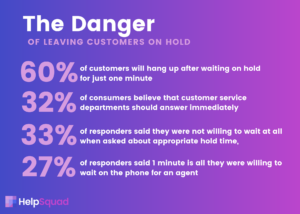Why and How Properly Deflect Customer Phone Calls
09 Nov 2022 By: Natalya Bucuy
Updated
Ahhhh, the 90s…The era of punk rock, rollerblades, and “the Rachel” haircut. While nostalgia brings some of these things back from time to time – welcome back, fanny packs! – some things should really stay in the 90s. That includes waiting on hold.
Frankly, there are few more annoying things for a customer than being stuck on hold with a company. One study showed that after waiting on hold for just one minute almost 60 percent of customers will hang up (Velaro.) In another survey, 32.3% of consumers believe that customer service departments should be answering immediately with no hold time. When asked how long they were willing to be put on hold, about a third of respondents said they were not willing to wait at all, 27.6 percent said 1 minute, and only 4.1 percent said they’d wait as long it took (PRWeb.)

Customers have better things to do. They do not want to wait on hold. That is why using features to deflect customer phone calls can be a simple solution. We will discuss why and how to do it. But first, let’s see what challenges businesses face today.
Contact Center Challenges
Contact centers can make or break the customer experience with a company. According to one report, 78 percent of consumers permanently change how they feel about a company based on a single interaction with the contact center (Forbes.)
Long call wait times are a common problem as contact centers experience agent churn and employee shortages. The last few years brought some changes to the workforce as well as shifts in the ways customers interact with companies.
During the pandemic, difficult calls increased by 50 percent overall. That, of course, made live chat agent jobs more difficult. Remote and hybrid work environments further challenged customer service employees. Customer satisfaction reflected these changes as 75 percent of respondents said customer service has gotten worse during the pandemic. Additionally, some 55 percent of callers did not get their issues resolved, a survey showed (CMSWire.)
Long wait times, drop calls, unresolved questions, free live chat software that sometimes means ineffective chatbots – all of these contribute to overall customer dissatisfaction. And so, while customers across various industries face the customer service crisis, it is an excellent opportunity for a company to stand out with better options. In the current environment, providing better customer service is a significant differentiator from the competition.
Customer Service the Digital Way
As we’re nearing the quarter mark of the 21st century (did anyone else get weird feels just now? 😨), it seems that digital interactions – texts, emails, web chats – are the way of the present and the future. So many of us prefer to text a friend rather than call. We’d rather contact a business via a web chat or Facebook Messenger to ask a simple question instead of calling.
However, when it comes to customer service, statistics show that phone calls are not yet ready to join telegrams and snail-mail letters on the “respected communication relics” shelf at the museum.
Recent Hiya’s 5th annual State of the Call report shows the following – somewhat surprising – results. (Business Wire)
- More than 12,000 consumers and 2,000 businesses ranked the phone call No. 1 for remote interactions, beating out text, email, video calls, and chatbots
- Nearly half of US businesses predict their use of the phone call will increase over the next 12 months
The report also lists the following rankings of communication channels:

Of course, each channel has its own set of pros and cons. In fact, various factors contribute to a certain channel’s popularity over the rest. A business’ customer demographics, location, type of inquiries, and customer support availability all play their own roles in a customer’s decision to use one communication channel over another. And so, in today’s consumer climate, all channels are invaluable. It’s not one over the other. People like options. And, therefore, to give people what they want and deliver the best customer experience companies must provide options.
Enter the IVR Call Deflect Option
When it comes to offering options to customers, omnichannel solutions have always been the key. The ability to contact customer service via various channels – web chat, text, phone call, email, or social media messages – makes a company versatile in terms of the communication preferences of its audience.
What takes customer experience to the next level is choice availability. And that is precisely what IVR feature to deflect customer calls provides.
Call Deflection is a feature that transfers a customer inquiry from one channel to another through the use of IVR (Interactive Voice Response) or Auto Attendant.
When a customer calls a company’s customer support line, IVR Deflect will switch the call to a text message conversation.
Call Deflection may seem like a way to deter customers from getting where they want to be – on the phone with an agent, resolving their issues. But that is not the case. The strategy brings options to customers in terms of which communication channel to use that is more convenient at the time.
“The goal of call deflection is to reroute them to an alternative service channel that can serve them faster and more efficiently.” (Techsee)
The practice brings enormous benefits to both the customer and the company. They include
- Reduction of expensive and time-consuming calls with more chats and text messages that are easier to manage
- Proactive and efficient customer support
- Increase of First Contact Response (FCR) rates as hung-ups due to long wait times reduce
- Shorter waits for the customer
- Increase in agent availability
- Reduction in customer support costs
Call deflect is easily configurable, please see how LiveHelpNow Call Deflect works.
Business Bottom Line with Use of Call Deflect
The last item on the list in the previous section deserves some extra attention. After all, lower costs of customer support is a great motivator to deflect customer phone calls.
The costs per call vary from business to business, but we can review some example costs based on averages. An average cost of a customer support phone call per minute is about $1/minute for a call center. (PriceItHere) An average customer call last about 10 mins, which is $10 per call per customer. Now, let’s say a customer chooses to defect the call and switch to text communication. The agent, who would have taken the call is now chatting with that customer. But that agent is also able to chat with other customers and attend to up to five chats in the same amount of time. This changes the cost per customer to only $.20 per minute.
Convenience, time, and cost savings? Yes, please!
Other Ways to Deflect Customer Phone Calls
As demonstrated, IVR Call Deflect to Text is a useful feature that helps both customers and agents. There are other options available to help deflect customer phone calls. Here are some examples:
- Get the customer to self-help.
- Send would-be callers to a Knowledge Base with rich content that helps them figure out their issues.
- Engage customers with a smart chatbot that can offer helpful suggestions based on the inquiry.
- Make the live chat and texting experience world-class so there is no need for customers to call.
Whatever options a company provides for its customers, the business strategy should always focus on making the customer experience better. Creating personal connections should be the primary goal as it boosts loyalty and keeps customers coming back. Just like those fanny packs.


